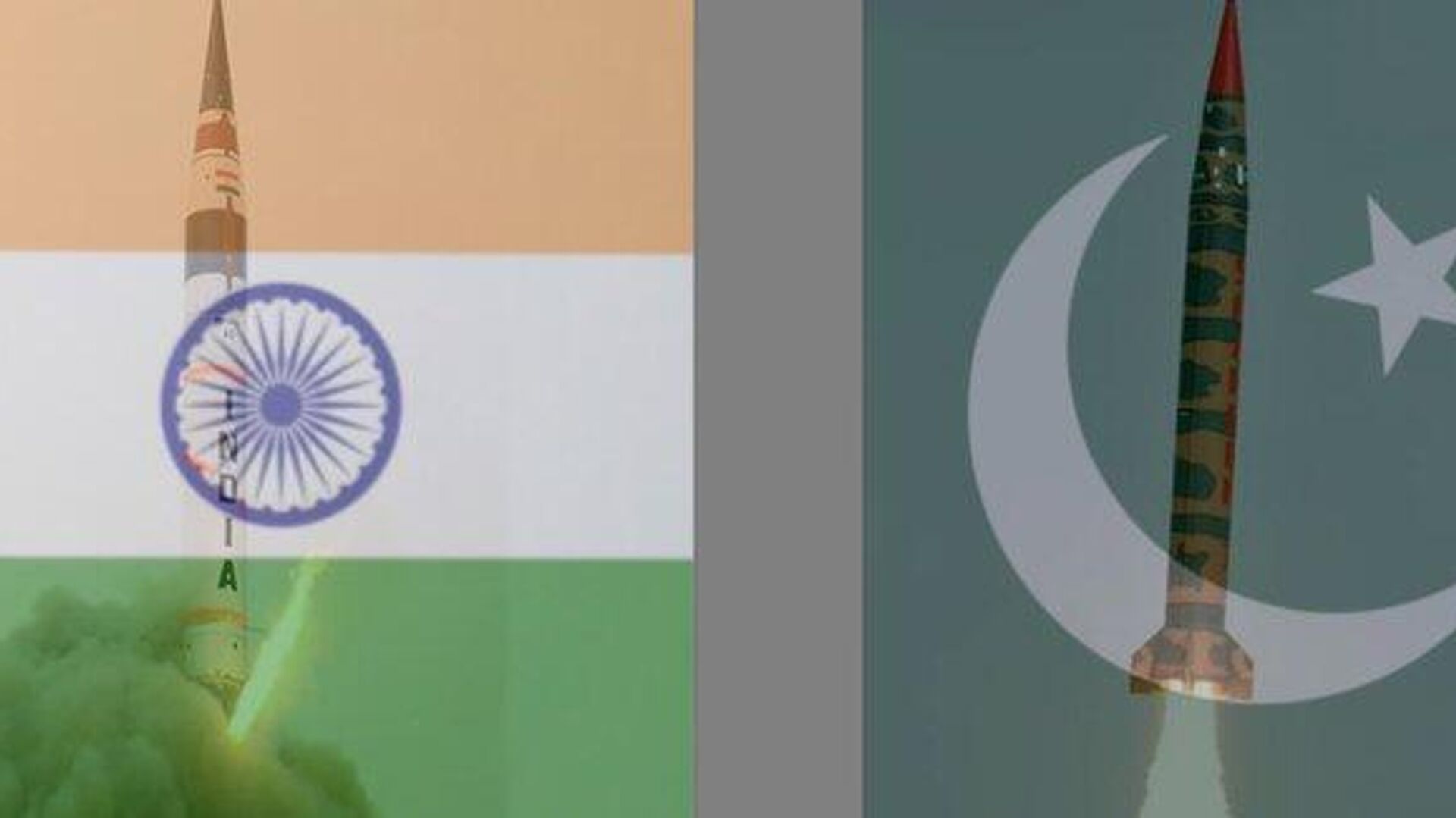https://sputniknews.in/20250428/what-do-india-and-pakistans-nuclear-strategies-say-9037386.html
What Do India and Pakistan's Nuclear Strategies Say?
What Do India and Pakistan's Nuclear Strategies Say?
Sputnik India
Amid rising tensions between nuclear-armed India and Pakistan following the Pahalgam terrorist attack, Sputnik India analyses the atomic doctrines of the two... 28.04.2025, Sputnik India
2025-04-28T20:47+0530
2025-04-28T20:47+0530
2025-04-28T20:47+0530
rajnath singh
atal bihari vajpayee
india
pakistan
rajasthan
nuclear weapons
islamabad
delhi
new delhi
kashmir conflict
https://cdn1.img.sputniknews.in/img/07e9/04/1a/9029359_58:0:636:325_1920x0_80_0_0_45a47ccac26e144b560c0accc5972498.jpg
India and Pakistan's nuclear arsenal is back in the limelight after the neighbouring states that have fought four wars since independence, appear to be on the brink following the Pahalgam massacre. The attack, which left 26 people dead, saw terrorists gunning down innocent tourists in the Baisaran Valley last week.Interestingly, the arch-foes have a starkly different nuclear doctrine, which they have used largely as a "deterrence" against each other. Both neighbours officially became nuclear weapons states in 1998, with India conducting five nuclear explosions in Pokhran, Rajasthan, that May, followed by Pakistan's nuclear tests just days later, cementing both nations' status as nuclear powers.But worth mentioning that India conducted its maiden atomic test, code-named Smiling Buddha, in May 1974 at the same site in Rajasthan. On the other hand, it is widely believed that Pakistan acquired the nuclear weapon capability in 1984.Notably, Pakistan does not commit to a "No First Use" nuclear policy. Instead, it adheres to a "full-spectrum deterrence" strategy designed to deter or halt Indian aggression on Pakistani territory.Furthermore, Pakistan is the only country with a declared nuclear doctrine that includes the potential use of tactical nuclear weapons on its own soil. Unlike most nuclear-armed states (except possibly North Korea), Pakistan reserves the right to initiate a nuclear strike on its own territory.Meanwhile, India adheres to a "No First Use" nuclear policy, declaring that its atomic arsenal was only meant for deterrent purposes.However, the Indian government under Prime Minister Atal Bihari Vajpayee asserted that India could exercise "massive retaliation" if an adversary attacked it first.India's doctrine also explicitly states that it will not use nuclear weapons against states that do not possess atomic weapons.Besides, India has strictly controlled the export of nuclear materials and technologies, while Pakistan has supported some countries' pursuit of nuclear weapons and facilitated illicit atomic proliferation.Nonetheless, India has debated changing its long-standing position on nuclear weapons. In 2019, Defence Minister Rajnath Singh underlined that if forced, India would make a U-turn on its 'No First Use' pledge.
https://sputniknews.in/20250426/india-vs-pakistan-military-strength-comparison-9027580.html
india
pakistan
rajasthan
islamabad
delhi
new delhi
kashmir valley
jammu and kashmir (j&k)
Sputnik India
feedback.hindi@sputniknews.com
+74956456601
MIA „Rossiya Segodnya“
2025
Pawan Atri
https://cdn1.img.sputniknews.in/img/07e6/0c/13/139630_147:0:831:684_100x100_80_0_0_8fa2b25903e7787fe6a2698552c167df.png
Pawan Atri
https://cdn1.img.sputniknews.in/img/07e6/0c/13/139630_147:0:831:684_100x100_80_0_0_8fa2b25903e7787fe6a2698552c167df.png
News
en_IN
Sputnik India
feedback.hindi@sputniknews.com
+74956456601
MIA „Rossiya Segodnya“
Sputnik India
feedback.hindi@sputniknews.com
+74956456601
MIA „Rossiya Segodnya“
Pawan Atri
https://cdn1.img.sputniknews.in/img/07e6/0c/13/139630_147:0:831:684_100x100_80_0_0_8fa2b25903e7787fe6a2698552c167df.png
rajnath singh, atal bihari vajpayee, india, pakistan, rajasthan, nuclear weapons, islamabad, delhi, new delhi, kashmir conflict, kashmir valley, jammu and kashmir (j&k)
rajnath singh, atal bihari vajpayee, india, pakistan, rajasthan, nuclear weapons, islamabad, delhi, new delhi, kashmir conflict, kashmir valley, jammu and kashmir (j&k)
What Do India and Pakistan's Nuclear Strategies Say?
Amid rising tensions between nuclear-armed India and Pakistan following the Pahalgam terrorist attack, Sputnik India analyses the atomic doctrines of the two nations.
India and
Pakistan's nuclear arsenal is back in the limelight after the neighbouring states that have fought four wars since independence, appear to be on the brink following the
Pahalgam massacre. The attack, which left 26 people dead, saw terrorists gunning down innocent tourists in the Baisaran Valley last week.
Interestingly, the arch-foes have a starkly different nuclear doctrine, which they have used largely as a "deterrence" against each other.
Both neighbours officially became nuclear weapons states in 1998, with India conducting five nuclear explosions in Pokhran, Rajasthan, that May, followed by Pakistan's nuclear tests just days later, cementing both nations' status as nuclear powers.
But worth mentioning that India conducted its maiden atomic test, code-named Smiling Buddha, in May 1974 at the same site in Rajasthan. On the other hand, it is widely believed that Pakistan acquired the nuclear weapon capability in 1984.
Abdul Qadeer Khan, the father of Pakistan's nuclear program, claimed the same year the Islamic state was "in a position to detonate a nuclear device on a week's notice," as mentioned in Air Power Journal.
Notably, Pakistan does not commit to a "No First Use" nuclear policy. Instead, it adheres to a "full-spectrum deterrence" strategy designed to deter or halt Indian aggression on Pakistani territory.
Furthermore, Pakistan is the only country with a declared nuclear doctrine that includes the potential use of tactical nuclear weapons on its own soil. Unlike most nuclear-armed states (except possibly North Korea), Pakistan reserves the right to initiate a nuclear strike on its own territory.
Meanwhile, India adheres to a "No First Use" nuclear policy, declaring that its atomic arsenal was only meant for deterrent purposes.
However, the Indian government under Prime Minister Atal Bihari Vajpayee asserted that India could exercise "massive retaliation" if an adversary attacked it first.
India's doctrine also explicitly states that it will not use nuclear weapons against states that do not possess atomic weapons.
Besides, India has strictly controlled the export of nuclear materials and technologies, while Pakistan has supported some countries' pursuit of nuclear weapons and facilitated illicit atomic proliferation.
Nonetheless, India has debated changing its long-standing position on nuclear weapons.
In 2019, Defence Minister Rajnath Singh underlined that if forced, India would make a U-turn on its 'No First Use' pledge.
"It is true that until now, India has strictly adhered to the 'No First Use' policy. But what happens in the future depends on the circumstances," Singh stated during a public address in Pokhran.



